
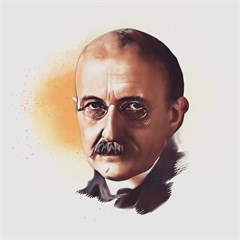 Max Planck
Max Planck
Physicist, Father of Quantum Theory, Nobel Prize
"I regard consciousness as fundamental. I regard matter as derivative from consciousness. We cannot get behind consciousness. Everything that we talk about, everything that we regard as existing, postulates consciousness."
The Observer
 Michael Levin, PhD
Michael Levin, PhD
Tufts University Biologist, Program Director
"The idea that cognition just magically shows up at some biological step, and then humans gain a true self... that runs against everything we know about evolution and developmental biology."
(A continuous spectrum of cognitive ability and agency)
Lex Fridman Interview
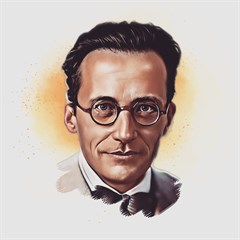 Erwin Schrödinger
Erwin Schrödinger
Physicist, Quantum Mechanics Pioneer, Nobel Prize
"Consciousness cannot be accounted for in physical terms. For consciousness is absolutely fundamental. It cannot be accounted for in terms of anything else."
Mind and Matter
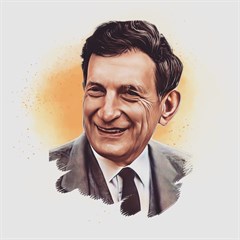 David Bohm
David Bohm
Physicist, Conscious Researcher, Philosopher
"Consciousness is much more of the implicate order than is matter ... Yet at a deeper level [matter and consciousness] are actually inseparable and interwoven, just as in the computer game the player and the screen are united by participation."
Wholeness and the Implicate Order
The Consciocentric Paradigm
There is an exciting shift occurring around the world right now -- leading to a new world view of consciousness. It is supported by the latest research in quantum foundations, thermodynamics, biology, neuroscience, and information theory. The scientific implications from various fields are converging, providing us a fascinating new view of consciousness, which is more fundamental and interconnected than classic materialist views have presumed.
Consciousness does not exclusively or arbitrarily emerge out of the brain, like some spontaneous magic trick.
Rather, consciousness is an intrinsic and ever present component of reality. Conscious potential is fundamentally tied to, and inseparable from all matter.
This is actually not even a new concept - in fact, it's one of the oldest philosophical theories of mind, dating back thousands of years to the time of Thales and Plato.
With the quantum mechanics revolution over the past hundred years, and cutting edge research in biophysics, information theory, and assembly theory it has re-emerged as the most likely depiction for how consciousness exists.
Consciousness (or Proto-Consciousness) is directly enfolded into the very fabric of our four dimensional space-time, and a principal driver for order, life, and the creative progression of the universe.
This is not meant to downplay the importance of the brain for consciousness. The brain is indeed a masterwork of consciousness, over trillions of iterations of evolution and millions of years. The brain is an advanced electromagnetic pattern decoding organ, a chemical processing center for the body, and transceiver which allows our conscious minds to have such a rich and consequential interaction with our bodies and surrounding 3D environment through 4D time.
Implications - The implications of fundamental consciousness are grandiose, but also very pragmatic and common sense when you consider day to day activities, and the taken for granted, but amazing capabilities of consciousness.
Consciocentrism is not some hippie new age belief which suggests an individual has broad capabilities to jump between disparate realities.
Consciocentrism does however posit that our minds have the capability to traverse the many-verse of possibilities, and we use these capabilities constantly, calling them memory, planning, forethought, visualization and alternate path consideration.
Reality itself, and the "solid moment of now" has a definite determinism to it, governed by The Schrödinger Equation and bound by causality at the resolution of the Planck constant.
Reality exists in a construct like the many-worlds framework outlined by the Relative State Formulation. The moment of now is a consensual composite of many worlds.
Jumping between variants of the many worlds medium is constrained by the consensual consciousness of matter.
 Erwin Schrödinger
Erwin SchrödingerPhysicist, Quantum Mechanics Pioneer
"By the principle of objectivation [ie: The Traditional Scientific Method]... we exclude the subject of cognizance from the domain of nature that we endeavor to understand ... Science must be made anew. Care is needed."
Mind and Matter
 Werner Heisenberg
Werner Heisenberg
Physicist, Quantum Pioneer, Nobel Prize
"The very act of observing disturbs the system."
"Science no longer is in the position of observer of nature, but rather recognizes itself as part of the interplay between man and nature. The scientific method ... changes and transforms its object: the procedure can no longer keep its distance from the object."
- At its core, this interpretation does indicate that the scientific method from Newtonian times is incomplete, without taking into account consciousness and the fundamental probabilistic and relativistic nature of quantum mechanics.
The traditional scientific establishment has been threatened by this for a hundred years since Relativity, Quantum Mechanics and the Schrödinger Equation shed astonishing new light on the nature of reality.
A Hundred Year History - All of the greats who helped unveil quantum mechanics grappled with this scientific paradox in the early to mid 20th century - but as world wars gripped the planet, considering the topic of "quantum foundations" and the big picture of reality fell out of favor.
The Copenhagen Interpretation of quantum wave collapse became dogma, despite its faults - and the greatest minds instead focused their energy on the direct wartime and technology applications of quantum mechanics and nuclear physics.
Our world has been completely revolutionized in the past hundred years,
but the elephant in the room among physicists, philosophers, and biologists is explaining the bewildering implications of quantum mechanics, and coming to grips with how consciousness relates to quantum fields, matter, and the Schrödinger equation.
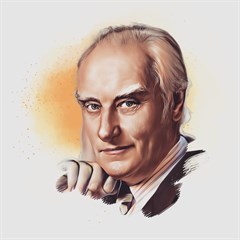 Francis Crick
Francis Crick
DNA Pioneer, Biophysicist, Nobel Prize
"Since the problem of consciousness is such a central one, and since consciousness appears so mysterious, one might have expected that psychologists and neuroscientists would now direct major efforts toward understanding it. This, however, is far from being the case. The majority of modern psychologists omit any mention of the problem, although much of what they study enters into consciousness. Most modern neuroscientists ignore it. ...Not only because of experimental difficulties but also because they considered the problem both too subjective and too "philosophical," and thus not easily amenable to experimental study."
- We may call this fundamental connection to matter "Proto Consciousness", as to differentiate it from other prevalent definitions of our highly evolved human consciousness -- though it all falls within the same continuous spectrum of consciousness.
There are different regions, or levels, of consciousness that are related to degrees of dimensional awareness (ie: 3D Matter, 4D Time, 5D Many Worlds) and the capacity for change over short or long time spans. Advanced biological life combines multiple spheres of consciousness within bodies, specializing in complimentary functions, and working in tandem to allow macro level focus of the body as a whole -- and at a further extrapolated level, our family, friends, communities and societies at large can be seen as extensions of shared specialization and collective conscious movements that shape our planet's future through ages and geological time spans.
This site examines evidence from classic physics, relativity, quantum mechanics, biology, chemistry, physiology, neuroscience, sociology, religion and philosophy.
 Brian Greene
Brian Greene
Theoretical Physicist, Mathematician, Educator
Regarding The Copenhagen Interpretation:
"Bohr advanced a heavyhanded remedy: evolve probability waves according to Schrödinger’s equation whenever you're not looking or performing any kind of measurement. But when you do look, Bohr continued, you should throw Schrödinger’s equation aside and declare that your observation has caused the wave to collapse. Now, not only is this prescription ungainly, not only is it arbitrary, not only does it lack a mathematical underpinning, it's not even clear. "
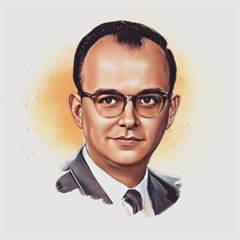 Hugh Everett
Hugh Everett
Physicist, Quantum Foundations Pioneer
"The Many-World's Interpretation is the only completely coherent approach to explaining both the contents of quantum mechanics and the appearance of the world."
- The subject of quantum foundations has been somewhat of a taboo topic in quantum physics circles for a hundred years. There are several "interpretations" of quantum wave collapse and the Schrödinger equation. The dogma / fallback has been the Copenhagen interpretation from way back in 1927 - but the "
Heisenberg Cut" and definition of a macro observer is highly problematic and arbitrary. The reason it has been kept as the fallback interpretation is that it was among the first, it was championed by Bohr and Heisenberg, and the quantum community instead focused the majority of time and efforts on technology and war applications of cutting edge energy and material sciences.
The greatest minds from the quantum revolution largely shied away from the subject of quantum foundations in universities or professional environments, though recently there has been renewed interest and debate. Consciocentrism most closely relates to Hugh Everett's Relative-State Formulation of quantum mechanics -- though the Consciocentric Interpretation expands upon Everett's paradigm with additional details on how the "many worlds" are not really separate at all, but rather like stacked onion skin layers which we exist in and transverse continuously through the consensual collective arrow of time.
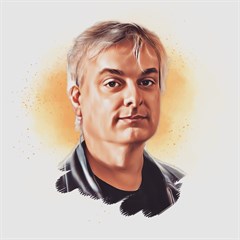 David Chalmers
David ChalmersPhilosopher and Cognitive Scientist
We won't have a theory of everything without a theory of consciousness.
- From a philosophy and metaphysics standpoint, the Consciocentric paradigm follows a theory of mind similar to panpsychism, though rather than saying all matter is conscious, Consciocentrism would say that all matter has "conscious potential". This site delves deep into the topic of panpsychism, and offers up examples and definitions of how there is a spectrum of consciousness from advanced life, down to organs, to single cells, to proteins, all the way down to the atomic level. Consciocentrism explores how
the fundamental force of electromagnetism is the key sense and actuation method that consciousness uses in a proto-conscious form. Also explored is how the strong nuclear force and gravity are intrinsically related to consciousness.
 Amit Goswami
Amit GoswamiPhysicist, Author
"With nonlocal connection, we are forced to conceptualize a domain of reality outside space-time because a nonlocal connection cannot happen in space-time."
- The Consciocentric Paradigm explores Special and General Relativity, 4D Spacetime and the underlying topic of dimensional relationships. Einstein's linking of the 3-dimensions of space with the 4th dimension of time into the construct of "spacetime" was a revolutionary idea a hundred years ago. Consciocentrism explores the meaning of dimensional promotion, in terms of what we experience as matter and time, and posits that consciousness actually exists not just in 4D spacetime, but in a five dimensional reality. The 5th dimension is intrinsically tied to Everett's Relative-State Formation and the "Many Worlds" interpretation for quantum foundations. The 5th dimension is the medium of Everett's "Many Worlds" and the probabilistic, wave-particle reality that is described by the Schrödinger equation. The 5th dimension allows for choice/freewill, nonlocality, quantum superposition, and the capabilities of consciousness to envision and plot out causality paths of alternate choices and future visualizations.
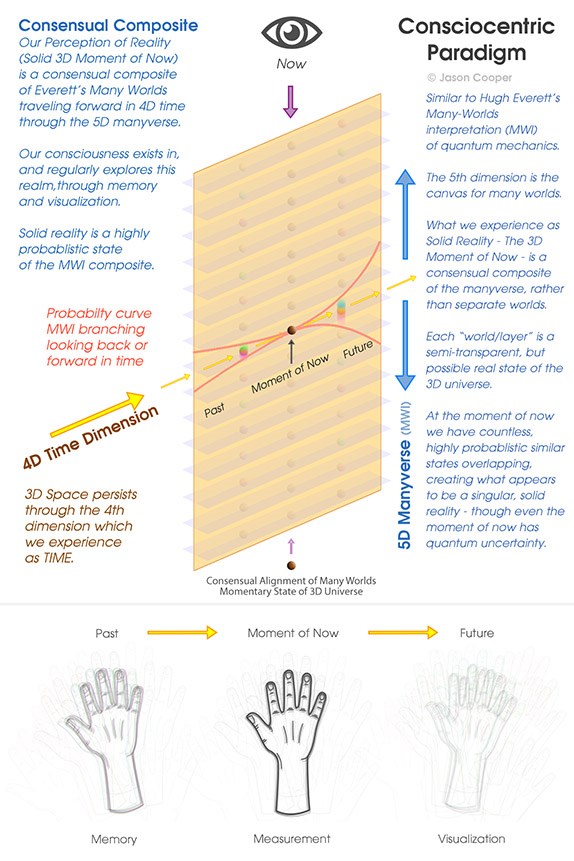
The 5-Dimensional Consciousness of Reality
We are all keenly aware of 3-Dimensional Matter that is the canvas for mass, and exhibits a width, depth and height. Our planet, our bodies, and all the objects we ever encounter are made of 3D matter, and located somewhere in the 3-Dimensional Cartesian Coordinate system.
The 4th Dimension of Time is one dimensional promotion up from the third.
Its existence renders the ability for change to all 3-Dimensional matter through the fourth dimension of time.
Consciocentrism posits that the 5th dimension is another dimensional promotion up from 4D spacetime, which allows for freewill, choice, and the conscious ability to access memories, have foresight, or consider alternate realities.
The 5th dimension is the canvas for Everett's Many Worlds Interpretation of Quantum Mechanics (MWI) and is an field of possible 4D spacetime continuums which we navigate based on the actions of the collective, consensual consciousness of 5D reality.
The "Moment of Now" is a result of the will of the collective consciousness of matter - a freeze frame of 3-Dimensional matter, derived from the 4D arrow of time and 5D canvas of collective MWI possibilities. We experience, and can measure objects in the "moment of now" as a very solid deterministic reality, however there is a small amount of uncertainty in even this very solid reality, and its continuous stream through the 4th and 5th dimensions.
In quantum mechanics, this concept of the probabilistic nature of matter and reality is well accepted -- at a fundamental level, a particle's existence in a given state, with a given 3D position has a degree of uncertainty to it, until it is observered by, or interacts with other matter.
One of the big questions that has swirled in physics circles is what constitutes "observation" and how much certainty we place on our measurements. Framed under the paradigm of fundamental consciousness, the observer need not be a human or biological life form, but just any matter, which is often a sticking point in these discussions.
The probabilistic nature of reality demonstrated in the landmark Schrödinger equation is perfectly supported in this interpretation of MWI. Even in the moment of now, reality isn't necessarily 100% solid. There are limits to our measurements and interaction with matter that leaves some haziness, however, in the moment of now, things are very solid overall, as the consensual composite of many worlds overlap at nearly the same agreed upon points.
As we sample moments back in time through memory, the probability of knowing the exact state of the universe is less clear, but is constrained somewhat by historic records, collective belief, and reverse causality. As we look forward to the future, the probability curve widens and we can make educated guesses based on causality and beliefs, but uncertainty of the many worlds of possibility provides a fuzzy window of visualization.
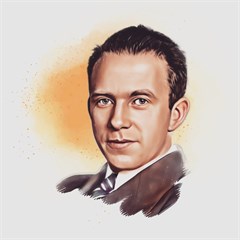 Werner Heisenberg
Werner HeisenbergPhysicist, Quantum Mechanics Pioneer
"There is a fundamental error in separating the parts from the whole, the mistake of atomizing what should not be atomized. Unity and complementarity constitute reality."
Physics from Wholeness
A Balance Between Separation and Unity
A balance between separation and unity is the most fundamental impulse and balancing point that consciousness deliberates.
From the very beginning of the universe, through the instinct to conceive life, through our daily personal choices, our familial and social relationships, and the socio-economic and political realities of our planet, everything is related to this fundamental balance between separation and unity.
This site will revisit this concept often and weave it into many other areas.